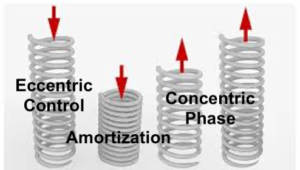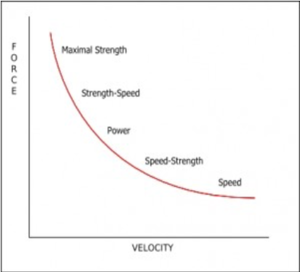
16 Jul Intro to Reactive Strength Index (RSI) – By Ben Smalley MSc & Caoimhe Morris MSc
By Ben Smalley (BSc, Msc) – DSS Sports Science and Caoimhe Morris (BA, MSc) – DSS Head of Education.
Download PDF Version here:
DSS S&C Blog Series 2 – Reactive Strength Index by Ben Smalley & Caoimhe Morris
Introduction
Explosive strength is a vital aspect of athletic performance, as it dictates both the amount of force developed and the rate that force is developed at. Explosive strength is important for various athletic tasks such as acceleration, change of direction and sprinting. Without explosive strength, team-based athletes would be less able both produce and absorb forces in competition.
A physical quality associated with explosive strength is ’reactive strength’. Reactive strength is a physical quality that encompasses the stretch shortening cycle (SSC) and refers to the muscle’s ability to absorb, amortize (stabilize or control), and finally, produce force.
Developing Explosive Strength
- Power focused resistance training
- Jumps / Plyometrics
- Sprinting
Benefits to Explosive Strength
- Enhanced Rate of Force Development (ability to apply force quickly)
- Ability of the muscles to absorb higher rates of force
- Reduced Injury Risk
Explosive strength = producing force at maximal velocity
Measuring Explosive Strength
A method of measuring reactive strength is through calculating the Reactive Strength Index of an athlete. RSI is the ratio between jump height & ground contact time and is calculated by dividing the former by the latter.
When we speak of RSI, we must also understand the Stretch-Shortening Cycle (SSC). The SSC is the muscle’s ability to absorb (eccentric), amortize (stabilize or control), and finally, produce (concentric) force. The competency of the muscle to engage in this cycle is a prerequisite of engaging in explosive movements. By measuring RSI, we are also measuring the function of the SSC mechanism.
As RSI is a measure of reactive strength, it must therefore be tested while performing an explosive / reactive movement. To calculate RSI, we require the athlete to perform a maximal plyometric movement and measure jump height and ground contact time. RSI is then calculated by dividing jump height by ground contact time.
Reactive Strength
= Measure of RSI
= Measure of SSC
- RSI is the measure of an athlete’s reactive strength
RSI = Jump Height
Ground Contact Time
The RSI Score directly relates to rate of force production, i.e explosive strength
- SSC is the ability of the muscle to absorb force, amortize/stabilise it and finally concentrically produce force. The speed at which SSC occurs directly relates to the RSI score.

Testing Procedure for RSI

The use of technology in athletic testing is necessary to gather valid, reliable and accurate data. Fortunately there are many methods for testing RSI, and many options available for gathering data. For this blog, we will use the example of a drop jump as the performance test, and will gather data using an Inertial Measurement Unit (IMU)
RSI is calculated using the time spent on the ground after dropping from the box (secs) and the jump height achieved (cm)
Interpretation of data
Once you have collected the Drop Height, Jump Height (cm) and Contact Time (cm), RSI is a simple calculation (see image 3 below).
The research surrounding the interpretation of RSI data is limited, however some work does exist from Flanagan et al (2016). From this work, we have some guidelines for RSI scores in a drop jump test, as outlined below
We want athletes to be able to both control & produce force in sporting contexts. Consequently, an athlete who has an RSI of below 2.0 for example, may indicate a window of opportunity for a plyometric programme to be be introduced. However, it is advised all team sport athletes include forms of plyometrics within training.
We also know that with a better RSI score, performance in various athletic tasks may improve. An athlete who can cycle through the SSC quickly and efficiently and still produce a high level of force will be better able to navigate the complex movements in sport safely.

Training to improve RSI Scores

Similar to our previous blog on Strength & Power Development, we also recommend considering the Force-Velocity Curve when designing training to enhance reactive strength. Whilst a range of loads are always advised to facilitate athletic development, typically plyometric type activities are required to develop the elastic qualities needed to improve RSI scores.
Developing Reactive Strength
We must also ensure we are training the body’s fast SSC (<250ms) ability. So, we must ensure the tasks the athlete undertakes are:
An example training progression can be seen below:

Conclusion
RSI is an important element of the testing procedure, and an athlete’s RSI score is something that coaches in all sports should test, monitor and develop as it is directly related to their performance in reactive/explosive tasks. An athlete without the ability to react efficiently is an athlete with a higher risk of injury.
As mentioned above, the production of force is not the only element at play in explosive movements. The absorption, control & stabilization of this force is as important, if not more important, in the development of explosive strength.
If the athlete can produce maximal explosive force, but cannot control & absorb it, the risk of injury increases exponentially.
While more research is required to provide different sports & positions normative data, the current research gives a good standing point. While there may not be peer-reviewed data for your particular sport, you can still work with the data from your own team and ensure that your athletes are following your own averages and/or position specific norms.
References
DSS Online Training
We are now currently offering online training tailored to individual needs.
We are offering varying pricing strategy which are outlined within the following link: https://elite.deelysportscience.com/dss-online-training/
This training support includes:
This support will be provided to you through the RYPT app. A fantastic resource for online training allowing top performance coaches to send programmes directly to your phone each week.
The App includes:
(To find out more visit their site at: https://www.rypt.app)
To gain access to a 2 month free trial to the RYPT app – click on the link here:



Gerard Reynolds
Posted at 13:26h, 17 JulySmall typo immediately preceding the reactive strength in bold writing at the start in that he states rsi is ground reaction time divided by height should be other way round
Ciaran Deely
Posted at 18:02h, 19 JulyThanks for the heads up Gerard! We will correct that now. Thanks again!
Bobby Carrigan
Posted at 14:48h, 26 Augustquick question – it states the RSI spectrum from Fair to Excellent are in the ranges on 1.5-2.5, the table shows ranges from 251-284.
Is there a formula then used to convert the table ranges to indicate where these scores lie on the RSI spectrum?
Caoimhe Morris
Posted at 13:52h, 27 AugustHey Bobby, great question! The conversion here is simple, the table displays scores direct from the calculation (jump height divided by grounf contact time) and to convert it to a RSI score we would simply place a decimal point after the first figure.
So 251 becomes 2.51, which would fall into the “Excellent” category.
Hope this helps!
Caoimhe